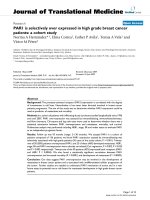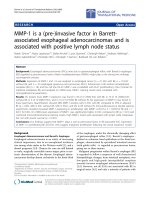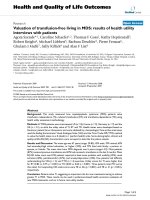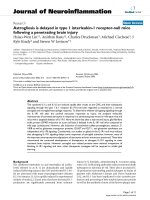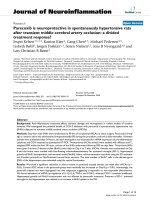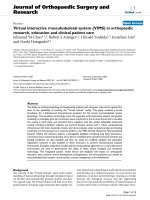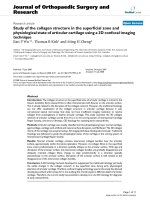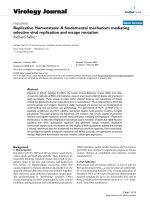Báo cáo hóa học: " MMP-1 is a (pre-)invasive factor in Barrettassociated esophageal adenocarcinomas and is associated with positive lymph node status" doc
Bạn đang xem bản rút gọn của tài liệu. Xem và tải ngay bản đầy đủ của tài liệu tại đây (1.57 MB, 11 trang )
Grimm et al. Journal of Translational Medicine 2010, 8:99
/>
RESEARCH
Open Access
MMP-1 is a (pre-)invasive factor in Barrettassociated esophageal adenocarcinomas and is
associated with positive lymph node status
Martin Grimm1†, Maria Lazariotou2†, Stefan Kircher3, Luisa Stuermer1, Christoph Reiber1, Andreas Höfelmayr1,
Stefan Gattenlöhner4, Christoph Otto1, Christoph T Germer1, Burkhard HA von Rahden1*
Abstract
Background: Esophageal adenocarcinomas (EACs) arise due to gastroesophageal reflux, with Barrett’s esophagus
(BE) regarded as precancerous lesion. Matrix metalloproteinases (MMPs) might play a role during the multistep
carcinogenetic process.
Methods: Expression of MMP-1 and -13 was analyzed in esophageal cancer (n = 41 EAC with BE, n = 19 EAC
without BE, and n = 10 esophageal squamous-cell carcinomas, ESCC), furthermore in BE without intraepithelial
neoplasia (IN) (n = 18), and the cell line OE-33. MMP-1 was co-labelled with Ki-67 (proliferation), Cdx-2 (marker for
intestinal metaplasia, BE) and analyzed on mRNA level. MMP-1 staining results were correlated with
clinicopatholocical parameters.
Results: On protein level, MMP-1 expression was found in 39 of 41 (95%) EAC with BE, in 19 of 19 (100%) EAC
without BE, in 6 of 10 (60%) ESCC, and in 10 of 18 (56%) BE without IN. No expression of MMP-13 was found in
these specimens. Quantification showed 48% MMP-1 positive cells in EAC with BE, compared to 35% in adjacent
BE (p < 0.05), 44% in EAC without BE, 32% in ESCC, and 4% in BE without IN. Immunofluorescence double staining
experiments revealed increased MMP-1 expressing in proliferating cells (MMP-1+/Ki-67+) (r = 0.943 for BE and r =
0.811 for EAC). On mRNA-level, expression of MMP-1 was significantly higher in EAC compared to BE (p = 0.01) and
confirmed immunohistochemical staining results. High MMP-1 levels were associated with lymph node metastases
but not with poorer survival (p = 0.307).
Conclusions: Our findings suggest that MMP-1 plays a role as preinvasive factor in BE-associated EAC. Expression
of MMP-1 in proliferating BE and EAC cells suggest malignant proliferation following the clonal expansion model.
Background
Esophageal Adenocarcinomas and Barrett’s Esophagus
Esophageal adenocarcinoma is an entity of increasing
clinical importance, due to an unexplained incidence
rise among white males in the Western world [1], and a
dismal prognosis [2,3]. Chances for cure are still limited
to early, surgically resectable tumor stages, prior to systemic dissemination of the disease. Esophageal adenocarcinomas develop almost exclusively in the distal third
*Correspondence:
†Contributed equally
1
Department of General-, Visceral-, Vascular and Pediatric Surgery, University
of Wuerzburg Hospital, Oberduerrbacher Strasse 6, 97080 Wuerzburg,
Germany
Full list of author information is available at the end of the article
of the esophagus, under the chronically damaging effect
of gastroesophageal reflux [2,3]. Barrett’s esophagus defined as columnar lined epithelium in the distal esophagus, characterized by specialized intestinal mucosa
(with goblet cells) - is regarded as precancerous lesion,
giving rise to these tumors.
Malignant progression within Barrett’s esophagus (BE)
is regarded to follow a sequence of well-characterized
histopathologic changes, from intestinal metaplasia, over
low-grade and high-grade intraepithelial neoplasia
towards invasive esophageal adenocarcinomas (EAC)
[2,3]. However, not all EACs are associated with BE in
surgical series [4,5], and only a minority of patients with
© 2010 Grimm et al; licensee BioMed Central Ltd. This is an Open Access article distributed under the terms of the Creative Commons
Attribution License ( which permits unrestricted use, distribution, and reproduction in
any medium, provided the original work is properly cited.
Grimm et al. Journal of Translational Medicine 2010, 8:99
/>
Barrett’s esophagus finally progress to cancer, with an
incidence between 0.5 and 2.0% per year [6].
These and other findings have raised doubt about the
relevance of Barrett’s esophagus as the precancerous
lesion of EAC (e.g. [7]), stimulating the search for the
cell population, from which esophageal adenocarcinomas originate, which is currently unknown.
The cell that gives rise to Barrett metaplasia is not
known. Recently, it has been hypothesized that intestinal
metaplasia may arise from a change in the differentiation pattern of stem cells that either reside in the esophagus or are recruited via the hematogenous route
from the bone marrow [8]. In addition, due to the multistep carcinogenesis, the clonal selection model implies
that malignant transformation occurs by multiple mutations in a random single cell and subsequent clonal
selection takes place [9-11].
Evidence is accumulating, that matrix metalloproteinases (MMPs) may drive carcinogenesis according to a
model of multistep carcinogenesis or a cancer stem cell
hypothesis mediated by the integrin collagen receptor
alpha(2)beta(1)-integrin pathway, which may also apply
to esophageal adenocarcinomas [11-15]. MMPs are a
family of highly homologous protein-degrading zinc
dependent enzymes, functioning as endopeptidases. This
family currently includes more than 25 members that
can be divided into collagenases (MMP-1, -8, and -13),
gelatinases (MMP-2 and 9), stromelysins (MMP-3 and
10), matrilysins (MMP-7 and 26), and the membranetype MMPs (MMP-14 to 17 and 24). Furthermore
MMPs are able to degrade the basement membrane of
vessels which is essential for tumor invasion into blood
and lymph vessels [14,16,17].
MMP-1 is a fibroblast-type or interstitial collagenase
and majorly secreted from fibroblasts, keratinocytes,
macrophages, but also cancer cells. MMP-13 is another
tumor-derived MMP that is implicated to have cooperative effects with MMP-1 and is related to cancer aggressiveness [18]. No data are currently available which
connect expression of MMP-1 and MMP-13 with
Barrett’s metaplasia and related EACs with the tumor
proliferation model of multistep carcinogenesis and clinicopathologic features. The aim of our study was to investigate expression of collagenases MMP-1 and -13 in EAC
(with and without associated BE) as well as non-dysplastic BE (without evidence of intraepithelial neoplasia and
carcinoma) and ESCC. We aimed to indicate their potential role as preinvasive factors in BE, to compare expression levels with adjacent EACs, and to investigate a
potential impact of MMP expression on survival, as well
as correlation with clinicopathologic features.
Page 2 of 11
Methods
Patients and Tumor Specimen
Surgical specimen from altogether 70 patients, having
undergone primary surgical resection for esophageal
cancer between January 2001 and June 2004 were
included in our study, furthermore n = 18 biopsies from
patients with non-dysplastic BE (without evidence of
invasive carcinoma or intraepithelial neoplasia). Patients
having undergone preoperative antineoplastic therapies
(chemoradiation/chemotherapy) were excluded. Only
patients in whom complete (R0) resection had been
achieved were included.
We used archieval formalin-fixed, paraffin-embedded
tissue from routine histopathologic work-up, which had
been performed under standardized conditions. The
material had been stored with permission of the local
ethics committee, after informed consent obtained from
the patients prior to surgical resection.
There were n = 41 esophageal adenocarcinomas
(EAC) with associated Barrett’s esophagus (BE), n = 19
EAC without BE and n = 10 esophageal squamous-cell
carcinomas of the esophagus (which were intended to
serve as positive control for MMP-1 expression), and n =
18 Barrett’s biopsies without intraepithelial neoplasia or
invasive carcinoma which were derived from patients
with gastroesophageal reflux disease (GERD). EAC
without BE was defined based on clinical information
(endoscopic evidence of Barrett’s mucosa), through
work-up of all tumor blocks (searching for specialized
intestinal metaplasia) and Cdx-2 staining performed in
addition, which has a 70% sensitivity for staining
intestinal metapasia [19].
Of note, the 19 EAC without BE were tumors in the
distal esophagus (AEG type I tumors, according to the
classification by Siewert and Stein, 1998, Br J Surg [20]),
and explicitly not localized at the level of the anatomic
gastric cardia (AEG type II tumors). The AEG type II
adenocarcinoma is a tumor entity on its own and must
be discussed differently.
Follow-up data were obtained from our local tumor
registry of Lower Franconia/Germany. This tumor registry documents all cancer patients in the area of Lower
Franconia/Germany. Information were obtained according to clinical visits of the patients (after 6 months, 12
months, 18 months, and thereafter one clinical visit per
year). Information about patients who did not participate in follow-up investigations were obtained from general practitioners. Follow-up was complete for all
patients (100%). Mean follow-up accounted for (29
months ± 17.6 standard deviation). Patient and tumor
characteristics are given in Table 1.
Grimm et al. Journal of Translational Medicine 2010, 8:99
/>
Page 3 of 11
Table 1 Clinicopathological characteristics of the EAC study
population (with and without histological proven BE)
Characteristics
Patients
(n = 60)
MMP-1 expression
EAC
Low
(<46%)
p-value
High
(≥ 46%)
Age (y)
.605
<66
30 (50%)
13 (43%)
17 (57%)
≥66
30 (50%)
14 (47%)
16 (53%)
Gender
Male
52 (87%)
24 (46%)
28 (54%)
Female
8 (13%)
5 (63%)
3 (37%)
.465
.032†
Histological
classification
G1
17 (28%)
11 (65%)
6 (35%)
G2
22 (37%)
12 (55%)
10 (45%)
G3/4
21 (33%)
6 (29%)
15 (71%)
pT1
16 (27%)
9 (56%)
7 (44%)
pT2
26 (43%)
14 (54%)
12 (46%)
pT3
pT4
10 (17%)
8 (13%)
3 (30%)
3 (38%)
7 (70%)
5 (62%)
.163††
Depth of invasion
Lymph nodes
metastasis
Immunohistochemical and immunofluorescent staining
.016
pN0
23 (38%)
16 (70%)
7 (30%)
pN1-3
37 (62%)
13 (35%)
24 (65%)
.163†††
UICC stage
UICC I
14 (23%)
8 (57%)
6 (43%)
UICC II
28 (47%)
15 (54%)
13 (46%)
UICC III
18 (30%)
6 (33%)
12 (67%)
0 (0%)
43 m
0 (0%)
47
(n = 29)
0 (0%)
38 (n = 31)
UICC IV
Median OS (m)
Tumor characteristics (UICC stage, pT-categories, pNcategories, cM-categories, number of removed lymph
nodes, number of tumor infiltrated lymph nodes, residual tumor status, location) and patient characteristics
were documented in a database (EXCEL, Microsoft).
Barrett’s mucosa was defined as specialized intestinal
metaplasia (IM), characterized by goblet cells and
disturbed glandular architecture [2,3]. In addition,
immunohistochemistry with caudal type homeobox
transcription factor 2 (Cdx-2), which is suggested as
early marker for intestinal metaplasia [23], was used to
identify tiny foci of intestinal metaplasia.
Furthermore, different degrees of high-grade and lowgrade intraepithelial neoplasia within Barrett’s mucosa
were assessed. EACs were classified as “EAC with BE”,
when at least tiny foci of intestinal metaplasia were
found due to Cdx-2 staining. EAC were classified as
“EAC without BE”, when the pathologists could not find
intestinal metaplasia on any of the tumor blocks.
EAC, esophageal adenocarcinomas; BE, Barrett metaplasia; y, years; G, grading;
UICC, International Union against Cancer; R, residual tumor; OS, overall
survival; m, months.
†
G1/2 vs. GT3/4; ††pT1/2 vs. pT3/4; †††UICC I/II vs. UICC III/IV.
Unconjugated MMP-1, Ki-67, and isotype control antibodies were purchased from Acris (Hiddenhausen,
Germany). The unconjugated Cdx-2 antibody was
obtained from Biogenex (San Ramon, USA) and the
unconjugated MMP-13 was provided by NeoMarkers
(Asbach, Germany). The secondary antibody used for
immunofluorescence double staining of Ki-67 was a
fluoresceinisothiocyanat (FITC)-conjugated AffiniPure
donkey-anti-rabbit IgG, used at 1:200 dilution (Jackson
ImmunoResearch Laboratories Inc., Suffolk, England).
The secondary antibody for MMP-1 was a Cy3-conjugated
AffiniPure donkey-anti-mouse IgG (Jackson ImmunoResearch), used at 1:200 dilution.
Cell Culture
Histopathologic Analysis, Tumor Staging and Definition of
Barrett’s mucosa
Tumor blocks of paraffin-embedded tissue were selected
by two experienced gastrointestinal pathologists (Stefan
Kircher, Stefan Gattenlöhner) on routine hematoxylin
and eosin (H&E) stained sections. Sections from all
available tumor blocks of all cases underwent intensive
histopathologic assessment, blinded to the prior histopathology report. H&E stained sections were analyzed
with special focus on tumor infiltrated areas (EAC/
ESCC), stromal areas and infiltrating immune cells.
Tumor staging was performed according to the 6th edition of the TNM staging system by the UICC/AJCC of
2002 [21]. Grading was performed according to WHO
criteria [22].
We analyzed MMP-1 and MMP-13 expression in cells
(1 × 104) from the esophageal adenocarcinoma cell line
OE-33 (Sigma-Aldrich, Steinheim, Germany) in cytospins. This cell line is the only commercially available
adenocarcinoma cell line of the lower esophagus (Barrett’s metaplasia) and was established from a 73-year-old
female patient. The tumor was identified as pathological
stage IIA (UICC) and showed poor differentiation.
Using RT-PCR we tested negative for mycoplasma contamination of this cell line that was provided to our
laboratory in December 2009 by Sigma. The cell line
was cultured in RPMI-1640 medium, supplemented with
10% Fetal Bovine Serum, 100 units/ml of penicillin and
100 μg/ml of streptomycin. Cytospins of the OE-33 cell
line were fixed in acetone and dried for 10 minutes.
Rehydration, blocking, and the staining procedure steps
were the same as described for immunohistochemistry
Grimm et al. Journal of Translational Medicine 2010, 8:99
/>
of FFPE sections. Additionally, RT-PCR was performed
for MMP-1 gene expression of OE-33 cells.
Double Staining Experiments (IF and IHC)
The sequential immunofluorescence (IF) double staining
(co-expression) was analyzed for MMP-1 with Ki-67
expression. Sequential immunohistochemical (IHC) double staining was performed for Cdx-2 and MMP-1.
Processing of tissue and staining procedure
First we assessed H&E sections from each tumor tissue
to differentiate between BE, tumor cell areas, stromal
areas and infiltrating immune cells. We then stained for
MMP-1, -13, Cdx-2, and Ki-67 in additional serial sections of 2 μm thickness. Tissue sections (2 μm thickness) were cut from paraffin blocks on a microtome and
mounted on adhesive microscope slides (Hartenstein,
Wuerzburg, Germany). Serial sections were deparaffinized in xylene and ethanol and rehydrated in water.
Heat induced epitope retrieval (HIER) was performed
with citrate buffer pH 6.0 (Dako, Hamburg, Germany).
For IF, slides were then incubated in normal serum (2%)
and bovine serum albumin (BSA) (0.5%) at room temperature for 20 minutes to block nonspecific binding.
Subsequently, slides were incubated with the primary
antibody or control antibody overnight at 4°C in
a humidified chamber and with secondary FITCconjugated antibody for 30 minutes at room temperature in a humidified chamber. The slides were incubated
with the second primary antibody diluted in TBS plus
0.5% BSA overnight at 4°C, followed by incubation with
the secondary Cy3-conjugated antibody for 30 minutes
at room temperature. Slides were counterstained with
DAPI (4’,6-Diamidino-2-phenylindoldihydrochlorid,
Sigma-Aldrich) and covered with Polyvinyl-alcohol
mounting medium (DABCO, Sigma-Aldrich) and analyzed using a Zeiss camera (Jena, Germany). The photographed images using the Metamorph software package
(Visitron Systems, Puchheim, Germany) were imported
into the Microsoft Office Picture Manager.
For IHC, the pretreatment procedure (fixation, deparaffinization, rehydration, HIER, and blocking) of the
slides was the same as described for IF. For immunohistochemical analysis a four-step immunoperoxidase
labeling for single antigens in formalin-fixed, paraffinembedded sections was used as described [24]. For
immunohistochemical double staining, we first used an
alkaline phosphatase (AP)-conjugated AffiniPure Donkey
anti-mouse Ab followed by 20 minutes of incubation
with Fast Red (Dako). After incubation with the second
primary antibody, we used a horseradish peroxidase
(HRP)-conjugated AffiniPure Donkey anti-rabbit IgG
(Jackson ImmunoResearch) followed by 5 minutes of
incubation with DAB (Biogenex).
Page 4 of 11
Quantification of Immunohistochemistry (IHC) and
Immunofluorescence (IF)
MMP-1 and Ki-67 IHC was quantified in EAC with BE,
as well as in the associated Barrett’s mucosa, as well as
EAC without BE. Quantification of immunoenzymatic
staining of IN or tumor cells was performed, analyzing
six representative individual high power fields (×400) for
each sample. Scoring was done by means of cell counting. The results were expressed as percentages (number
of positive cells within 100 counted tumor cells, %). Sections were evaluated by two independent blinded investigators separately. In case of discrepancies, both
evaluated the slides simultaneously and made an agreement. For each tumor section, quantification of IF double staining was performed by counting Ki-67+ cells in
six microscopic high power fields (400 × magnification)
in parallel with MMP-1+. The proportion of Ki-67 positivity in counted MMP-1+ cells was expressed in
percentages.
Real-time quantitative reverse transcription-PCR analysis
To analyze gene expression of MMP-1 by RT-PCR in
FFPE tissue, we extracted total cellular RNA and performed cDNA synthesis using the Absolutely RNA FFPE
Kit and the AffinityScript QPCR cDNA Synthesis Kit
from Stratagene (Waldbronn, Germany). Areas of interest for each tissue section were manually microdissected.
For both groups (BE and EAC) equal amounts of tissue
areas were assessed (2 × 1.5 cm2 surface area per section,
thickness of 10 μm). For OE-33 cell line, after homogenization Diethyl pyrocarbonate (DEPC)-75% ethanol was
added to the lysate to provide ideal binding conditions.
The lysate was then loaded onto the RNeasy silica membrane (“RNeasy Mini spin column”, RNeasy Mini Kit Qiagen, Hilden, Germany). RNA binds, and all contaminants
were washed away efficiently. Pure, concentrated RNA
was eluted in water and stored at -70°C until further analysis. The amount of total RNA was determined by measuring absorbance at 260 nm. The purity of total RNA was
established by confirming that the 260 nm:280 nm ratio
was within a 1.8-2.0 range, indicating that the RNA preparations were free of protein contaminants. Primers
were designed using the Primer Express software for primer design to amplify short segments of 50-150 base
pairs of target cDNA. The MMP-1 forward primer
sequence was: 5′-TGCTGCTGCTGCTGTTCTGGG-3′;
the MMP-1 reverse primer sequence was: 5′-GGCCGATGGGCTGGACAGGA-3′. Matched human esophageal
cDNA was purchased by BioChain (Hayward, CA, USA)
as control. The housekeeping gene Glyceraldehyde-3phosphate dehydrogenase (GAPDH) was used for relative
quantification and cDNA quality control. The GAPDH
forward primer sequence was: 5′-ATCCCATCACCATCTTCCAGG-3′; the GAPDH reverse primer sequence
Grimm et al. Journal of Translational Medicine 2010, 8:99
/>
was: 5′-CGCCCCACTTGATTTTGG-3′. RT-PCR reactions were carried out as described previously [25]. The
relative quantification value, fold difference, is expressed
as 2-ΔΔCt.
Statistical analysis
Statistical analysis was performed with MedCalc Software, Version 11.3.2 (Mariakerke, Belgium). All values
were expressed as Median ± Interquartile Range (IQR)
because D’Agostino-Pearson test did not show a normal
distribution of gene and protein expression. Therefore,
the Median value was chosen to divide patients in two
different groups. Survival time was determined as the
time from tumor resection to tumor conditional death
and as the time from tumor resection to time of obvious
recurrence. The overall survival (OS) time in association
with MMP-1 expression was estimated using the
Kaplan-Meier method [26]. To analyze differences in
the overall/tumor related survival among patients after
successful (R0) curative surgical resection for EAC
patients were divided into two subgroups (dichotomous
variables). Median cut-off value for either high or low
expressors was set at 46% for MMP-1 expression in all
EAC (n = 60). The log rank test was used to check for
statistical differences between the survival curves. Cases
with less than 10% positive cells were regarded as
negative.
Multivariate analyses were performed using the Cox
Proportional Hazards Model. All parameters that were
found significant on univariate analysis were included [27].
Correlation analysis was performed by the non-parametric Spearman Rho rank correlation coefficient. Fisher’s exact test was used to investigate the relation
between two categorical variables. Data were analyzed
using the non-parametric Mann-Whitney U test or
Kruskal-Wallis test when more than 2 groups were
compared. P values of less than 0.05 were regarded statistically significant.
Results
MMP-1 expression is associated with BE and associated
EAC
MMP-1, MMP-13 and Cdx-2 were not expressed in
normal esophageal squamous epithelium. MMP-1
expression in stromal cells was considerably weak and
strongly associated with high-grade and low-grade
intraepithelial neoplasia within Barrett’s mucosa as
well as cancer cells. 95% (n = 39/41) of the patients
with BE and adjacent EAC expressed MMP-1 within
the tumor. Similarly, 100% (n = 19/19) of the EAC
without BE expressed MMP-1, 6 of 10 ESCC (60%),
and 10 of 18 (56%) Barrett’s biopsies without intraepithelial neoplasia or carcinoma stained positive for
MMP-1.
Page 5 of 11
Expression of MMP-13 was negative in tumor specimen and in the esophageal adenocarcinoma cell line
OE-33, but was rarely detected in stromal cells (data not
shown).
Furthermore, we analyzed positivity of all counted
cells according to the precursor lesion and tumor entity.
Compared to BE (GERD) without intraepithelial neoplasia or carcinoma (Figure 1a, Table 2), MMP-1 expression was significantly upregulated in BE (Figure 1a,
Table 2) with adjacent EAC (Figure 1a, Table 2) and
EAC without BE (Figure 1a, Table 2). No differences of
MMP-1 expression were found between different
degrees in high-grade and low-grade intraepithelial neoplasia within Barrett’s mucosa. Median MMP-1 expression of all EACs (n = 60) was 46%, IQR 39.0 - 55.5%;
95% CI 43.0 - 54.0%.
ESCC showed significantly decreased MMP-1 expression (Figure 1a, Table 2), compared to EACs. For
adenocarcinomas without BE, the results of MMP-1
expression were comparable with the higher expression
levels of adenocarcinomas from BE. Expression levels of
MMP-1 in ESCC did not differ significantly from BE
with adjacent EAC but showed a decrease compared to
BE (Figure 1a, Table 2).
Figure 1b demonstrates a representative example of
MMP-1 expression in early BE. We confirmed areas
analyzed for MMP-1 expression of BE by immunohistochemical double staining with Cdx-2 (Figure 1c). Figure
1d demonstrates a representative example of MMP-1
expression in EAC. Stainings from the OE-33 adenocarcinoma cancer cell line in cytospins served as additional
positive control for MMP-1 expression and showed 65%
positive cells (Figure 2a).
Analysis of MMP-1 gene expression
To confirm the results of the immunohistochemical
staining, gene expression of MMP-1 in human BE and
EAC were assessed. MMP-1 gene expression in BE
(Median 3.6-fold difference compared to normal tissue;
IQR 3.275 to 4.625-fold difference; n = 5) was significantly (p = 0.01) lower in comparison to EAC without
BE (Median 7.9-fold difference compared to normal tissue; IQR 6.3 to 8.95-fold difference; n = 4; Figure 2b).
These results confirmed increased MMP-1 expression in
BE and significantly elevated expression of MMP-1 in
EAC without BE as observed by immunohistochemistry.
RT-PCR results for MMP-1 expression in the adenocarcinoma cell line OE-33 showed a 4.1-fold higher expression compared to normal tissue.
MMP-1 expression is strongly correlated with
proliferating (Ki-67+) Barrett and EAC cells
For investigation of proliferating cells in BE and EAC
and its relation to multi-step carcinogenesis, we
Grimm et al. Journal of Translational Medicine 2010, 8:99
/>
Page 6 of 11
Figure 1 Immunohistochemical analysis and staining of MMP-1 in human BE and EAC. In comparison to BE without intraepithelial neoplasia
(GERD) (1) a significantly (p < 0.05) increased expression of MMP-1 was observed in BE adjacent to EACs (2). Expression levels of MMP-1 were
significantly (p < 0.05) increased in associated EACs (3) and EACs without BE (4). ESCC showed significantly (p < 0.05) decreased MMP-1 expression
compared to EACs (5). Analysis refers to percentages of positivity of all counted cells. Grey lines show 95% confidence intervals. Statistically
significant values from BE and ESCC to EACs are indicated with asterisks (a). Increased expression of MMP-1 (b) was observed in early BE (arrows).
Adjacent normal tissue stained negative for MMP-1 (asterisk). Single staining of MMP-1 in BE was confirmed by immunohistochemical double
staining (c), showing Cdx-2 (nuclear staining pattern, Fast red) and MMP-1 (cytoplasmic staining pattern, brown). Significantly increased MMP-1
expression was observed in adenocarcinomas compared to BE (d). Original magnification: top × 100, bottom × 200.
analyzed MMP-1 expression in early Barrett cells,
adjacent EAC, EAC without BE and ESCC. Evaluation
of immunohistochemically stained serial sections
showed a strong positive correlation of MMP-1
expression with proliferating cells (Figure 3a and 3b:
MMP-1+/Ki-67+: r = 0.943 for BE, n = 41 and r =
0.811 for EAC, n = 60). As shown in Figure 3c by an
immunofluorescence double staining, MMP-1 was coexpressed with great amounts of proliferating (Ki-67+)
cells in areas which were associated with early BE
(goblet cells as well as Cdx-2 positivity were
observed in serial sections) (Figure 3c, representative
example of n = 41 BE). IF double staining confirmed
correlation analysis evaluated in IHC serial sections.
We found a dominant population of proliferating
MMP-1+/Ki-67+ cells in BE and EAC. Proliferation
status (Ki-67+) itself did not have had any impact on
survival (data not shown).
Grimm et al. Journal of Translational Medicine 2010, 8:99
/>
Page 7 of 11
Table 2 MMP-1 expression of the study population in different tissues
Tissue
n
Median expression (%)
IQR (%)
95% CI
BE without intraepithelial neoplasia or carcinoma (GERD)
18
4
0-11
0-10.603
p-value
BE adjacent EAC
41
35
23.0-41.5
31.284-39.0
<0.05†
Adjacent EAC to BE
41
48
39.0-56.5
43.0-54.239
<0.05††
EAC without BE
19
44
39.0-55.8
39.0-55.218
<0.05††
ESCC
10
27
0-50.2
0-29.2
<0.05†††
BE, Barrett metaplasia; GERD, Gastro-Esophageal Reflux Disease; EAC, esophageal adenocarcinomas; ESCC, esophageal squamous-cell carcinomas; †significance is
related to GERD; ††significance is related to BE with adjacent EAC; †††significance is related to EACs.
Prognostic value of MMP-1 in adenocarcinomas
To analyze survival differences of patients after successful (R0) curative surgical resection for EAC with and
without BE, patients were divided into two subgroups as
described above (dichotomous variables). Lymph node
metastasis (pN+, Table 3, pT-category (pT3/4, Table 3)
and grading (G3/4, Table 3) were shown to be unfavorable factors in univariate analysis of all (n = 60) EACs.
Moreover, we found a strong association between high
MMP-1 expression and positive lymph node metastases
(p = 0.016136582, Fisher’s exact test, Table 1) in EAC
patients (n = 60). To analyze differences in tumor
related survival dependent on MMP-1-expression in
EAC we divided the patients in two subgroups as
described above (dichotomous variables). Survival in
subgroup with high MMP-1 expression of all EACs (n =
60; Figure 4, Table 1) was not significantly worse in
comparison to the subgroup of patients with low expression of MMP-1 (Figure 4, Table 1). Data show that
MMP-1 expression in BE and adjacent EACs is associated with clinicopathologic features which may predict
worse clinical outcome of adjacent EACs. Multivariate
analysis using the Cox Proportional Hazards Model
demonstrate lymph node metastases and grading as
independent prognostic factors in all (n = 60) EACs
(Table 4).
Discussion
‘Tissue invasion and metastasis’ is one of the six ‘hallmarks of cancer’, initially described by Hanahan and
Weinberg [28,29]. Invasive and metastatic capabilities
are largely mediated by extracellular proteases, which
are able to destroy the environment of the tumor cell.
MMPs have been shown to be involved in this process.
The early work of Liotta et al. [30] provided some of
the first evidence that MMPs were involved in invasion
of a tumor cell through the basement membrane. Previous studies described MMP-9 in the pathogenesis of
Barrett’s esophagus, ESCC, and gastric cancer [31-33].
However, we have focused on MMP-1 and MMP-13
expression, because no data have been available regarding clinicopathological factors in BE and EAC so far.
Our findings of an increased MMP-1 expression in EAC
is well in line with results obtained in other cancer entities and few samples of EAC without clinicopathological
association [34-41] suggesting a putative role in invasion, metastasis and poorer survival. In this context,
MMP-13 has been shown to play a role in tumor
Figure 2 Immunohistochemical staining of MMP-1 from the OE-33 adenocarcinoma cancer cell line and MMP-1 gene expression in
human BE and EAC. MMP-1 staining in cytospins from the OE-33 adenocarcinoma cancer cell line served as additional positive control (left)
and showed 65% positive cells; IgG control (right) (a). Gene expression of MMP-1 in human BE and EAC. MMP-1 gene expression in BE was
significantly (p = 0.01) lower in comparison to EAC without BE. Normal tissue is considered as one-fold (b). Statistically significant value is
indicated with an asterisk.
Grimm et al. Journal of Translational Medicine 2010, 8:99
/>
Page 8 of 11
Figure 3 Correlation and co-expression of Ki-67 with MMP-1. Correlation from quantified immunohistochemical staining results of MMP-1+
in BE (n = 41) and EAC (n = 60) with proliferating cells (Ki-67+) showed that Ki-67+ expression in BE (a) and EACs (b) had a strong direct
correlation with the expression of MMP-1+ (r = 0.943 for BE and r = 0.811 for EAC). (c) Images demonstrate a representative example of Ki-67
co-expression with MMP-1+ by an immunofluorescent double staining in early BE showing the majority of proliferating (Ki-67+) cells with MMP-1+
(big arrows). Small arrows indicate goblet cells. FITC green Fluoresceinisothiocyanat, Cy3 red, and DAPI 4’,6-Diamidino-2-phenylindoldihydrochlorid
blue. Top, Calibration bar represents 50 μm. Bottom, calibration bar represents 25 μm. The square box at the bottom demonstrates the area which
is also shown in larger magnification.
Grimm et al. Journal of Translational Medicine 2010, 8:99
/>
Page 9 of 11
Table 3 Univariate analysis of prognostic factors of the patients (n = 60)
Variable
Unfavorable factor
Hazard ratio (HR)
95% CI of HR
LN
positive
12.1940
5.9509 to 24.9867
p-value
<0.0001
Depth of invasion
pT3/4
3.8447
1.5309 to 9.6553
<0.0001
Grading
High (G3/4)
4.0652
1.7123 to 9.6514
<0.0001
MMP-1 expression
High (≥46%)
1.4526
0.7101 to 2.9718
0.3070
LN, Lymph nodes metastasis.
progression of other gastrointestinal tumor entities such
as colorectal carcinoma [42], and hepatocellular carcinoma [43]. In gastric cancer and specimen with human
esophageal carcinomas (ESCC) MMP-13 expression has
been previously shown to contribute to malignant progression. It has furthermore been suggested that its
coordinate overexpression with MMP-1 and/or MMP-2
may have a synergetic effect in tumor progression
[18,44]. In sharp contrast to these findings, in our study,
MMP-13 was not found expressed in EACs, but was
occasionally detected in surrounding stromal cells.
Therefore, based on our results, we may exclude this
cooperative effect in patients with EAC.
Our findings of high MMP-1 expression being associated with lymph node metastases in patients with EAC
indicate that MMP-1 expression may be involved in
Figure 4 Overall survival curves calculated by Kaplan-Meier
method in Barrett associated adenocarcinomas. High levels of
MMP-1 expression in EAC (n = 60) were not found to be associated
with poorer survival (p = 0.307). The times of the censored data are
indicated by short vertical lines.
promotion of cancer progression in addition to other
clinicopathological characteristics. However, we have
not been able to demonstrate a negative impact of
increased MMP-1 expression on survival.
To date molecular pathogenesis of BE is poorly understood. According to the clonal evolution model we
found a dominant population of proliferating cells (Ki67+) in EAC, which may drive multi-step carcinogenesis
[45]. We have chosen to study proliferation with Ki-67,
because it is a proliferation-associated nuclear antigen
and expressed in all cycling cells except for resting cells
in the G0 phase, which implies no negative survival
effect [46] but may be associated with neoplastic progression in BE [47]. Therefore, our results may indicate
that MMP-1 expression is associated with multistep carcinogenesis according to clonal selection model from BE
to EAC. Furthermore, we hypothesize MMP-1 signaling
in the pathogenesis of adenocarcinomas by the integrin
collagen receptor alpha(2)beta(1)-integrin pathway
which has been shown to be involved human prostate
epithelial stem cells [15]. In osteosarcoma cells the level
of cell surface alpha(2)beta(1)-integrin correlates with
the expression level of native collagenase MMP-1 [48].
Therefore, the investigation of this signalling pathway
might be a promising target for future investigations in
the carcinogenesis of Barrett’s esophagus. However, to
date there are no experimental data that support this
hypothesis [11].
Additionally, the findings of elevated gene and protein
expression of MMP-1 by BE and EAC as preinvasive
factor might also be important for esophageal squamous-cell carcinomas, although it was only investigated
in a smaller sample. A critical role of MMP-1 for promoting invasion and metastasis in this tumor entity has
been described earlier [49].
Conclusions
MMP-1-expression was found in a major population of
proliferating MMP-1+ Barrett and EAC cells. Expression
of MMP-1 in proliferating (Ki-67+) cells of intestinal
metaplasia and in Barrett-associated adenocarcinomas
may thus sustain multi-step carcinogenesis and further
tumor growth. These findings may contribute to the
further understanding of the pathogenesis of esophageal
carcinogenesis. Furthermore, MMP-1 seems to be in
Grimm et al. Journal of Translational Medicine 2010, 8:99
/>
Page 10 of 11
Table 4 Multivariate analysis of prognostic factors of the patients (n = 60)
Variable
Unfavorable factor
Hazard ratio (HR)
95% CI of HR
p-value
LN
positive
9.1861
2.0665 to 40.8346
0.003746
Depth of invasion
pT3/4
1.2336
0.2783 to 5.4683
0.7834
Grading
High (G3/4)
2.2593
1.0171 to 5.0186
0.04643
LN, Lymph nodes metastasis.
respect of the integrin collagen receptor alpha(2)beta(1)pathway, which has been associated with a putative stem
cells hypothesis in prostate cancer. This signaling pathway might be promising for further investigations in the
carcinogenesis of Barrett-associated adenocarcinomas
due to a cancer stem cell hypothesis.
7.
8.
9.
10.
Acknowledgements
The authors thank the assistance of Mrs. Manuela Schneider and Mrs. Sabine
Gahn for their technical support. We thank the Senator Kurt and Inge
Schuster Stiftung, Wuerzburg and the excellence academy of the chairmen
of the Deutsche Gesellschaft für Allgemein- und Visceralchirurgie (DGAV) for
their financial support. For S.G and S.K the work was supported by the
Wilhelm-Sander Foundation (Grant 2007.068.1).
Author details
1
Department of General-, Visceral-, Vascular and Pediatric Surgery, University
of Wuerzburg Hospital, Oberduerrbacher Strasse 6, 97080 Wuerzburg,
Germany. 2Department of Cardiac and Thoracic Surgery, University of
Wuerzburg Hospital, Oberduerrbacher Strasse 6, 97080 Wuerzburg, Germany.
3
Institute of Pathology, University of Wuerzburg, Josef-Schneider Strasse 2,
97080 Wuerzburg, Germany. 4Institute of Pathology, Medical University of
Graz, Auenbruggerplatz 25, 8036 Graz, Austria.
Authors’ contributions
GM conceived the study, carried out immunohistochemistry studies,
performed the statistical analyzes and drafted the manuscript. LM
participated in the design of the study and performed RT-PCR studies. SK
and SG participated in the design of the study, evaluated cancer samples,
and helped to draft the manuscript. CR and LS participated in the design of
the study, and performed immunohistochemistry studies. AH helped to draft
the manuscript. CO and GCT participated in the design of the study design
and coordination and drafted the manuscript. VRBHA participated in the
design of the study design, performed preliminary RT-PCR and
immunohistochemistry studies and drafted the manuscript. All authors read
and approved the final manuscript.
Competing interests
The authors declare that they have no competing interests.
Received: 21 June 2010 Accepted: 14 October 2010
Published: 14 October 2010
11.
12.
13.
14.
15.
16.
17.
18.
19.
20.
21.
22.
References
1. Pohl H, Welch HG: The role of overdiagnosis and reclassification in the
marked increase of esophageal adenocarcinoma incidence. J Natl Cancer
Inst 2005, 97(2):142-146.
2. von Rahden BHA, HJ S: Barrett’s Esophagus and Barrett’s Carcinoma. Curr
GERD Rep 2007, , 1: 125-132.
3. Spechler SJ: Clinical practice. Barrett’s Esophagus. N Engl J Med 2002,
346(11):836-842.
4. Sabel MS, Pastore K, Toon H, Smith JL: Adenocarcinoma of the esophagus
with and without Barrett mucosa. Arch Surg 2000, 135(7):831-835,
discussion 836.
5. Liu GS, Gong J, Cheng P, Zhang J, Chang Y, Qiang L: Distinction between
short-segment Barrett’s esophageal and cardiac intestinal metaplasia.
World J Gastroenterol 2005, 11(40):6360-6365.
6. Shaheen N: Is there a “Barrett’s iceberg?”. Gastroenterology 2002,
123(2):636-639.
23.
24.
25.
26.
27.
Jamieson GG: Antireflux surgery, barrett esophagus, and
adenocarcinoma: there is still room for doubt. Ann Surg 2007,
246(1):22-23.
Souza RF, Krishnan K, Spechler SJ: Acid, bile, and CDX: the ABCs of
making Barrett’s metaplasia. Am J Physiol Gastrointest Liver Physiol 2008,
295(2):G211-218.
Nowell PC: The clonal evolution of tumor cell populations. Science 1976,
194(4260):23-28.
Campbell LL, Polyak K: Breast tumor heterogeneity: cancer stem cells or
clonal evolution? Cell Cycle 2007, 6(19):2332-2338.
Zhang HY, Spechler SJ, Souza RF: Esophageal adenocarcinoma arising in
Barrett esophagus. Cancer Lett 2009, 275(2):170-177.
Bradbury PA, Zhai R, Hopkins J, Kulke MH, Heist RS, Singh S, Zhou W, Ma C,
Xu W, Asomaning K, et al: Matrix metalloproteinase 1, 3 and 12
polymorphisms and esophageal adenocarcinoma risk and prognosis.
Carcinogenesis 2009, 30(5):793-798.
Mroczko B, Kozlowski M, Groblewska M, Lukaszewicz M, Niklinski J,
Laudanski J, Chyczewski L, Szmitkowski M: Expression of matrix
metalloproteinase-9 in the neoplastic and interstitial inflammatory
infiltrate cells in the different histopathological types of esophageal
cancer. Folia Histochem Cytobiol 2008, 46(4):471-478.
Murray GI, Duncan ME, O’Neil P, McKay JA, Melvin WT, Fothergill JE: Matrix
metalloproteinase-1 is associated with poor prognosis in oesophageal
cancer. J Pathol 1998, 185(3):256-261.
Collins AT, Habib FK, Maitland NJ, Neal DE: Identification and isolation of
human prostate epithelial stem cells based on alpha(2)beta(1)-integrin
expression. J Cell Sci 2001, 114(Pt 21):3865-3872.
Tanioka Y, Yoshida T, Yagawa T, Saiki Y, Takeo S, Harada T, Okazawa T,
Yanai H, Okita K: Matrix metalloproteinase-7 and matrix
metalloproteinase-9 are associated with unfavourable prognosis in
superficial oesophageal cancer. Br J Cancer 2003, 89(11):2116-2121.
Salmela MT, Karjalainen-Lindsberg ML, Puolakkainen P, Saarialho-Kere U:
Upregulation and differential expression of matrilysin (MMP-7) and
metalloelastase (MMP-12) and their inhibitors TIMP-1 and TIMP-3 in
Barrett’s oesophageal adenocarcinoma. Br J Cancer 2001, 85(3):383-392.
Etoh T, Inoue H, Yoshikawa Y, Barnard GF, Kitano S, Mori M: Increased
expression of collagenase-3 (MMP-13) and MT1-MMP in oesophageal
cancer is related to cancer aggressiveness. Gut 2000, 47(1):50-56.
Phillips RW, Frierson HF Jr, Moskaluk CA: Cdx2 as a marker of epithelial
intestinal differentiation in the esophagus. Am J Surg Pathol 2003,
27(11):1442-1447.
Siewert JR, Stein HJ: Classification of adenocarcinoma of the
oesophagogastric junction. Br J Surg 1998, 85(11):1457-1459.
Sobin LH, Ch W: UICC. TNM Classification of Malignant Tumors Springer
Verlag, 6 2002.
Hamilton SR, Aaltonen LA: Pathology and Genetics. Tumours of the Digestive
System IARC Press, third 2000.
Moons LM, Bax DA, Kuipers EJ, Van Dekken H, Haringsma J, Van Vliet AH,
Siersema PD, Kusters JG: The homeodomain protein CDX2 is an early
marker of Barrett’s oesophagus. J Clin Pathol 2004, 57(10):1063-1068.
Gattenlohner S, Waller C, Ertl G, Bultmann BD, Muller-Hermelink HK, Marx A:
NCAM(CD56) and RUNX1(AML1) are up-regulated in human ischemic
cardiomyopathy and a rat model of chronic cardiac ischemia. Am J
Pathol 2003, 163(3):1081-1090.
Grimm M, Gasser M, Bueter M, Strehl J, Wang J, Nichiporuk E, Meyer D,
Germer CT, Waaga-Gasser AM, Thalheimer A: Evaluation of immunological
escape mechanisms in a mouse model of colorectal liver metastases.
BMC Cancer 10:82.
Kaplan EL, Meier P: Nonparametric estimation from incomplete
observations. J Am Stat Assoc 1958, 75:457-487.
Cox DR: Regression models and life tables. J R Stat Soc 1972, , 34:
1987-2001.
Grimm et al. Journal of Translational Medicine 2010, 8:99
/>
28. Hanahan D, Weinberg RA: The hallmarks of cancer. Cell 2000, 100(1):57-70.
29. Morales CP, Souza RF, Spechler SJ: Hallmarks of cancer progression in
Barrett’s oesophagus. Lancet 2002, 360(9345):1587-1589.
30. Liotta LA, Tryggvason K, Garbisa S, Hart I, Foltz CM, Shafie S: Metastatic
potential correlates with enzymatic degradation of basement membrane
collagen. Nature 1980, 284(5751):67-68.
31. Herszenyi L, Hritz I, Pregun I, Sipos F, Juhasz M, Molnar B, Tulassay Z:
Alterations of glutathione S-transferase and matrix metalloproteinase-9
expressions are early events in esophageal carcinogenesis. World J
Gastroenterol 2007, 13(5):676-682.
32. Li Y, Ma J, Guo Q, Duan F, Tang F, Zheng P, Zhao Z, Lu G: Overexpression
of MMP-2 and MMP-9 in esophageal squamous cell carcinoma. Dis
Esophagus 2009, 22(8):664-667.
33. Li Y, Sun DL, Duan YN, Zhang XJ, Wang N, Zhou RM, Chen ZF, Wang SJ:
Association of functional polymorphisms in MMPs genes with gastric
cardia adenocarcinoma and esophageal squamous cell carcinoma in
high incidence region of North China. Mol Biol Rep 37(1):197-205.
34. Vegh I, Santiuste AD, Colina F, Bor L, Bermejo C, Aragon A, MoranJimenez MJ, Gomez-Camara A, De Salamanca RE, Moreno-Gonzalez E:
Relationship between biomarker expression and allelic alteration in
esophageal carcinoma. J Gastroenterol Hepatol 2007, 22(12):2303-2309.
35. Okazaki I, Wada N, Nakano M, Saito A, Takasaki K, Doi M, Kameyama K,
Otani Y, Kubochi K, Niioka M, et al: Difference in gene expression for
matrix metalloproteinase-1 between early and advanced hepatocellular
carcinomas. Hepatology 1997, 25(3):580-584.
36. Bendardaf R, Buhmeida A, Ristamaki R, Syrjanen K, Pyrhonen S: MMP-1
(collagenase-1) expression in primary colorectal cancer and its
metastases. Scand J Gastroenterol 2007, 42(12):1473-1478.
37. Sunami E, Tsuno N, Osada T, Saito S, Kitayama J, Tomozawa S, Tsuruo T,
Shibata Y, Muto T, Nagawa H: MMP-1 is a prognostic marker for
hematogenous metastasis of colorectal cancer. Oncologist 2000,
5(2):108-114.
38. Vizoso FJ, Gonzalez LO, Corte MD, Rodriguez JC, Vazquez J, Lamelas ML,
Junquera S, Merino AM, Garcia-Muniz JL: Study of matrix
metalloproteinases and their inhibitors in breast cancer. Br J Cancer 2007,
96(6):903-911.
39. Yamamoto H, Itoh F, Iku S, Adachi Y, Fukushima H, Sasaki S, Mukaiya M,
Hirata K, Imai K: Expression of matrix metalloproteinases and tissue
inhibitors of metalloproteinases in human pancreatic adenocarcinomas:
clinicopathologic and prognostic significance of matrilysin expression. J
Clin Oncol 2001, 19(4):1118-1127.
40. Inoue T, Yashiro M, Nishimura S, Maeda K, Sawada T, Ogawa Y, Sowa M,
Chung KH: Matrix metalloproteinase-1 expression is a prognostic factor
for patients with advanced gastric cancer. Int J Mol Med 1999, 4(1):73-77.
41. Lee CH, Liu SY, Lin MH, Chiang WF, Chen TC, Huang WT, Chou DS, Chiu CT,
Liu YC: Upregulation of matrix metalloproteinase-1 (MMP-1) expression
in oral carcinomas of betel quid (BQ) users: roles of BQ ingredients in
the acceleration of tumour cell motility through MMP-1. Arch Oral Biol
2008, 53(9):810-818.
42. Leeman MF, McKay JA, Murray GI: Matrix metalloproteinase 13 activity is
associated with poor prognosis in colorectal cancer. J Clin Pathol 2002,
55(10):758-762.
43. Altadill A, Rodriguez M, Gonzalez LO, Junquera S, Corte MD, GonzalezDieguez ML, Linares A, Barbon E, Fresno-Forcelledo M, Rodrigo L, et al:
Liver expression of matrix metalloproteases and their inhibitors in
hepatocellular carcinoma. Dig Liver Dis 2009, 41(10):740-748.
44. Elnemr A, Yonemura Y, Bandou E, Kinoshita K, Kawamura T, Takahashi S,
Tochiori S, Endou Y, Sasaki T: Expression of collagenase-3 (matrix
metalloproteinase-13) in human gastric cancer. Gastric Cancer 2003,
6(1):30-38.
45. Visvader JE, Lindeman GJ: Cancer stem cells in solid tumours:
accumulating evidence and unresolved questions. Nat Rev Cancer 2008,
8(10):755-768.
46. Heeren PA, Kloppenberg FW, Hollema H, Mulder NH, Nap RE, Plukker JT:
Predictive effect of p53 and p21 alteration on chemotherapy response
and survival in locally advanced adenocarcinoma of the esophagus.
Anticancer Res 2004, 24(4):2579-2583.
47. Kerkhof M, Steyerberg EW, Kusters JG, van Dekken H, van Vuuren AJ,
Kuipers EJ, Siersema PD: Aneuploidy and high expression of p53 and Ki67
is associated with neoplastic progression in Barrett esophagus. Cancer
Biomark 2008, 4(1):1-10.
Page 11 of 11
48. Shingleton WD, Hodges DJ, Brick P, Cawston TE: Collagenase: a key
enzyme in collagen turnover. Biochem Cell Biol 1996, 74(6):759-775.
49. Yamashita K, Mori M, Kataoka A, Inoue H, Sugimachi K: The clinical
significance of MMP-1 expression in oesophageal carcinoma. Br J Cancer
2001, 84(2):276-282.
doi:10.1186/1479-5876-8-99
Cite this article as: Grimm et al.: MMP-1 is a (pre-)invasive factor in
Barrett-associated esophageal adenocarcinomas and is associated with
positive lymph node status. Journal of Translational Medicine 2010 8:99.
Submit your next manuscript to BioMed Central
and take full advantage of:
• Convenient online submission
• Thorough peer review
• No space constraints or color figure charges
• Immediate publication on acceptance
• Inclusion in PubMed, CAS, Scopus and Google Scholar
• Research which is freely available for redistribution
Submit your manuscript at
www.biomedcentral.com/submit
